Atomization and spray systems have a wide range of applications, such as in combustion devices like jet propulsion engines, diesel engines, industrial boilers, and furnaces. Atomization generally refers to a process in which a bulk liquid is disintegrated into small drops or droplets by internal and/or external forces as a result of the interaction between the liquid and the surrounding medium. The disintegration or breakup occurs when the disruptive forces exceed surface tension forces. External forces, such as aerodynamic forces, surface shear forces, centrifugal forces and electrostatic forces, acting on the liquid surface may distort the bulk liquid and promote the disruption. External forces may lead to oscillations and perturbations of the interfaces. These oscillations may be amplified and result in the breakup of the liquid into small droplets. This initial breakup process is often referred to as the primary breakup or the primary atomization. A population of larger droplets produced in the primary atomization may be unstable if they exceed a critical droplet size and thus may undergo further disruption into smaller droplets. This process is usually termed as the secondary breakup or the secondary atomization. Therefore, the final droplet size distribution produced in an atomization process is determined by the flow characteristics and the properties of the fluids in both the primary and secondary disintegration.
SPRAY CHARACTERIZATION
Spray characteristics is referred to as the spray droplet size distribution, droplet velocity distribution and droplet number density or concentration. The need to know the spray characteristics has prompted the development of various instruments and measurement techniques. These techniques are divided into four major categories: impact, thermal, electrical and optical methods. The optical methods have the major advantage of being non-intrusive and therefore more accurate. Among the different optical techniques photographic techniques were the first to be used in order to analyze sprays and provide information about both the size and velocity of the drops. The constraints associated with a photographic analysis of the sprays are as follows.
(1) The Illumination: the smaller and faster the droplets, the more intense the illumination has to be. Short light pulses are required to freeze the spray so that the droplets do not move more than two drops diameters. Two pulses are necessary if information about the velocity is to be obtained. The velocity is then determined by the length of the streak on the image.
(2) Magnification: a large magnification is required to determine small droplets. However, the lower limit of discernible droplets is around 5µm.
(3) Depth of field: the larger the magnification, the smaller the depth of field. Droplets outside the plane of focus are not clear, and might even not be visible. Specifically designed optical systems are then required.
Other photographic methods based on the use of pulsed ruby-laser that allow high intensity exposure of 20 ns have been developed. In order to avoid the constraints associated with small depth of field, 3 dimensional holographic analysis of sprays have been realized. The main limitation of the photographic methods is the extraction of the information from the picture. Manual analysis of the photography based on the estimation of the observer is often inaccurate, whereas the implementation of semi-automatic and automatic data extraction with image processing techniques proves to be rather complex.
Contrary to the photographic methods described above, the non-imaging optical techniques are based on the Mie scattering theory. Light incident on a spherical particle is scattered in all the directions, and the scattered intensity is a function of both the scattering direction, the drop radius and index of refraction of the drop. The methods based on this theory are further subdivided into ensemble scattering methods and single particle counters, and represent at present time the most powerful diagnostic tools for particle size analysis. The laws of geometric optics yield an accurate approximation to the Mie scattering theory, valid for particles large compared to the wavelength of the incident light and for near forward scattering directions. The light scattered by different drop sizes present in a polydispersed and dilute spray in a direction is equal to the sum over the size classes present in the spray of the intensity scattered by the droplets of a same size class, weighted by the corresponding concentration of the class. If a lens is placed in front of the spray, the intensity recorded by an annular detector in the focal plane of the lens at a given radial distance of the optical axis will depend on the concentration of each size class in the spray. In Single Particle Counter (SPC) methods a non-collimated laser beam (the transmitter) is focused on the spray and therefore defines an optical sample volume. This volume can be thought of as a region of the space where a drop will generate a signal by scattering the light of the incident beam. A receiver is used to record the intensity scattered by the particle as it goes through the probe volume. For near forward scattering angles, which are nevertheless large enough to neglect the diffraction effects, the intensity of the scattered light is proportional to the square of the radius of the particle. Hence the size of the particle can be determined, and the velocity is obtained from the time required for the particle to go through the sampling probe.
Various instruments based on this principle have been developed and the most widely used to date is the Phase Doppler Particle Analyzer (PDPA). Spray characterization was greatly improved with this instrument which allows simultaneous and accurate measurements of both the drop sizes and velocities. The transmitter consists of two laser beams which interfere in the probe volume. As a particle goes through the probe volume, the transmitted interference pattern is recorded by (at least) two receivers. The velocity of the particle is derived from the movement of the scattered interference fringes detected by the receiver as the particle goes through the probe volume. The size is given by the phase shift of the intensity burst detected by the different receivers.
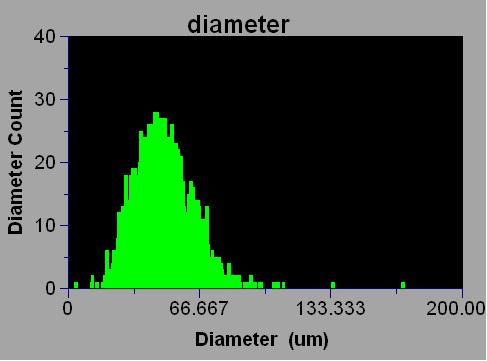
In addition to the above methods, we have developed a technique based on the farfield imaging of the spray. Therefore, it can provide spray characteristics throughout the whole spray. It is neither point measurement nor line of sight measurement. It uses the local drop scattering theory along with tomographic reconstruction of the spray using farfield images for extracting the spray parameters. Tomographic reconstruction techniques are used whenever information inside the flowfield is sought. Two different tomographic techniques are commonly used, namely, transmission and emission tomography. When a beam of energy goes through an object, the photons of the beam are absorbed and scattered by the particles of the object. The global effect of these particles is to remove or scatter energy from the beam as it crosses the object.
Our laboratories are equipped to perform detailed characterization of various types of sprays. Both small size spray nozzles and large industrial size sprays can be tested in our environmentally controlled chambers. We have developed correlations for various types of sprays by detailed spray characterizations.
(See Facilities)
ATOMIZATION AND SPRAY MODELING
MUSSL is developing numerical models for the primary atomization with emphasis on the investigation of the global parameters of the spray such as the liquid core and intact lengths, mean droplet size and spray spreading angle. The ultimate goal is to develop a computational tool for the design and optimization of nozzles and injectors for sprays and aerosols. In this direction we are using free surface flow modelings to simulation the complex interfaces between the liquid and the atomizing gas. The following picture shows numerical simulation of Kelvin-Helmholtz instability between two fluids.

We are using DNS, LES and RANS models in our simulations. In our RANS simulations, we are considering the turbulence effects at the interface. The presence of interface affects the turbulent structures and they become anisotropic near the interface. By means of physical interpretation and turbulence modeling, the effects of turbulence fluctuations on the interface and vice-versa are considered. The following picture shows the interface of a turbulent liquid jet in air.
SPRAY COMBUSTION
We have been involved in both experimental and numerical studies of spray combustion systems and their application in diesel engines, gas turbines and boilers. These studies related to the determination of the combustion efficiencies and the emission formations. Fuel sprays were characterized and their influence on the combustion product was investigated. We are currently using a Planar Laser Induced Fluorescent system to determine both the species concentration and the spray size and velocity distribution simultaneously. This unique system allows us to directly determine the correlation between the spray characteristics and the combustion products.
DROPLET COLLISIONS – EXPERIMENTS
Drop collision studies are relevant to a broad spectrum of fields ranging from large scales such as astrophysics and meteorology, to much smaller scales as seen in aerosols and nuclear physics. We have been conducting experimental research on the collision dynamics of liquid droplets. Our research has focused on the determination of the collision outcomes in terms of various controlling parameters, such as the Weber and the Reynolds numbers.
Experimental observations suggest that there are five major types of outcome when two liquid masses collide in a gaseous environment. They are bouncing, partial coalescence, coalescence, separation, and shattering. In a bouncing collision contact of drop surfaces is prevented by the intervening gas film, and drops bounce apart without any mass exchange. A partial coalescence collision happens only for drops with very large size difference and very small velocities. The small drop attaches to the big drop and flows into the big drop because of the pressure difference between them. Before the small drop is completely absorbed by the large drop, the surface tension cuts off the bridge and a secondary drop is generated.

Coalescence collisions refer to the collisions in which two drops permanently combine and generate one single drop. A separation collision is one in which drops coalesce temporarily and later separate into one single string of two or more drops of various sizes. And shattering collision, which is the characteristic of high relative velocity collision, is one in which the collided drops disintegrate into a cluster of many liquid fragments shortly after the collision. These five types are only the most general ones, more sub-categories within them can be defined if number of drops generated, mass transfer rate, and shape relaxation rate, etc. are taken into account.
DROPLET COLLISIONS – ANALYTICAL
Two different analytical models are developed for the separating collisions, namely reflexive and stretching separation models. Reflexive separation is found to occur for near head-on collisions, while stretching separation occurs for large-impact-parameter collisions.

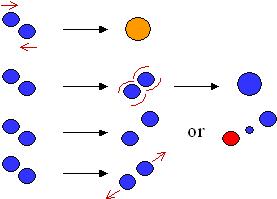
For more information, see Collision-Off Axis (PPT).
DROPLET COLLISIONS – COMPUTATIONAL
Presentation on Head-on Collision Simulations (PPT)
Presentation on Off-Axis Collision Simulations (PPT)
Paper on Drop Collisions (PDF)
We have conducted three-dimensional numerical simulations of drop collisions with and without the effect of the surrounding environment. Our numerical models are based on an Eulerian, finite-difference, Volume-of-Fluid method. Surface tension is included using the Continuum Surface Force method. Both head-on and off-axis collisions are modeled numerically. A separation criterion based upon deformation data is found. The effect if Reynolds number investigated and regions of permanent coalescence and separation are plotted in the Weber-Reynolds number plane. The role of viscosity and its effect on dissipation is also investigated. Finally, the validity of the assumptions made in some of the collision models is assessed.
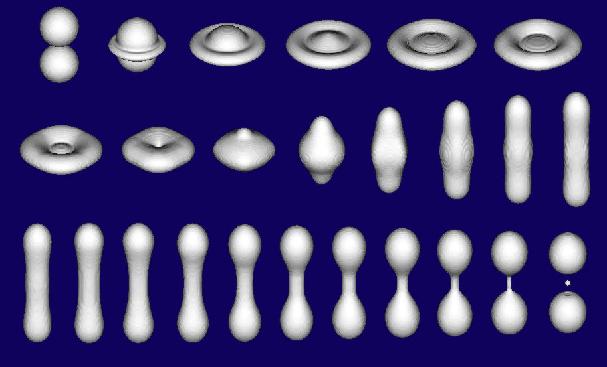
DROPLET IMPACTION
Presentation on Drop Impaction (PPT)
The problems of droplet impacts on a porous substrate have been encountered in the daily life. A hot water drop stream passes through the filtered ground coffee is what many people normally do the first thing in the morning. In a rainy day, raindrops fall on the ground and soils act just as a filter to allow water to penetrate through into the underground channel. In industry, droplets are widely chosen to increase the total contact surfaces of the flows and help improve the efficiency of designs significantly. For examples, fuel injecter injects small droplets to increase the combustion capability. Spray humidifier uses droplets to raise the evaporation rate. One of the most direct application of droplet impacts on porous media, however, is in inkjet printing on papers. This technology has been proven and adopted to become one of the most home-used printing techniques at the least cost. With the development of digital camera, people can even print photographs directly using an inkjet photo printer at home very efficiently. It is the demand of the technologies that motivates the current study.
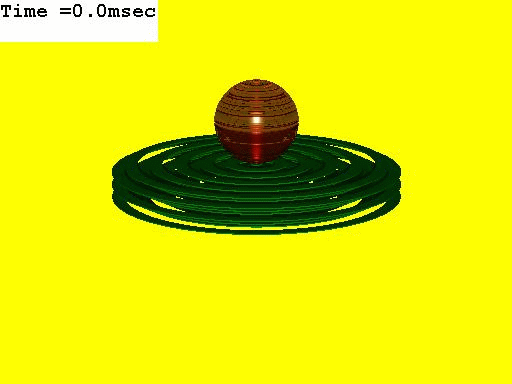
Droplet impacts on a porous substrate is a problem involving with very complicated and intriguing physics. When a droplet impacts on a solid surface, it either spreads or rebounds. A similar situation occurs as a droplet impacts on a porous substrate. In addition to spreading and rebounding, a capillary penetration of the liquid droplet into the porous substrate may be resulted as well depending on the flow conditions of the incoming mother droplet interacted with the contact surfaces. Droplets may penetrate into the substrate either wholly or partially. In some cases, they may not even penetrate at all. These phenomenon are critical to the final equilibrium state of the droplets on porous substrates and are crucial for distinguishing the final performance of the spreading especially as inkjet printing is concerned. The spreading of an inkjet droplet on papers determines the resolution of the printing significantly. To improve the process requires knowledge among droplet impacts, droplet spreading and droplet penetration altogether. Since the problems involve impacts and penetration of droplets on a porous substrate, it is beneficial to understand the physics involved. A series of literature research has been included. Hopefully, they can provide some understanding toward the physics of these problems and serve as a starting point of the present study.
DROP-SHOCK INTERACTION
The aim of this research is to better understand the effects of a planar shock wave impinging on a fluid droplet. The procedure is started by the creation of vaccuum in a shock tube, and then rupturing the membrane placed at one end of the shock tube. The shock wave that is produced travels the length of the shock tube passing through two pressure transducers, which are mounted flush with the inner tube walls. Each transducer sends a signal to a charge amplifier where the signal is amplified and then sent to the addition and compatibility circuits. These circuits convert the shock wave’s signal into a square wave, which triggers a preset time delay.
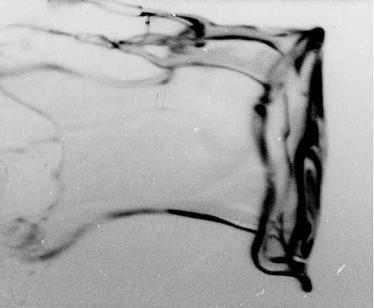
The time delay holds the signal for the preset time, and then triggers a light to flash which takes a picture of the shock wave impinging on a fluid droplet. The fluid drop generator is located above the window of the shock tube, and produces liquid droplets as the shock wave passes by. Camera and flash mechanizms are placed in front of this window, enabling the shock wave and droplet interaction to be captured on film when triggered by the delay timer. The analysis of the resulting pictures will advance the understanding of the fuel injection systems, and advanced material coating technologies.
DROPLET COMBUSTION
We have investigated the combustion of single droplets of fuel in various environments. Both suspended and free flowing droplets are experimentally studies. We have two different combustion chambers: One is an electrically heated chamber and the other is a combustion combustion chamber which produces hot combustion gases using a flat flame burner. The electrically heated furnace is used for a controlled environment studies. This chamber can be free from water vapor. Droplets are injected at the top of these chambers and their combustion during their flight is observed using direct imaging.
LIQUID JETS – EXPERIMENTS
Paper on Evaporating Jets (PDF)
A liquid jet issuing from a nozzle may breakup into small drops when it is subjected to even minute disturbances. These disturbances can be in the form of surface displacement, pressure or velocity fluctuations in the supply system or on the jet surface, as well as fluctuations in liquid properties such as temperature, viscosity, or surface tension coefficient. In order to characterize the instability of a capillary jet, a harmonic disturbance is imposed on the surface of the jet and its growth rate is investigated. Such investigations have revealed that the jet is unstable for axial disturbances with wavenumbers less than a cut-off wavenumber k(c), and stable otherwise. For each wavelength of an unstable disturbance one main drop and one or more usually smaller drop(s), referred to as the satellite or spherous drop(s), are formed.
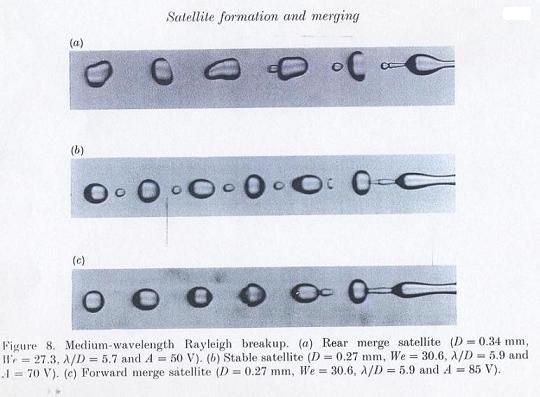
The main objectives of the studies on the liquid jet instability have been to obtain the growth rates of the initial disturbances (as a function of the disturbance wavenumber), the cut-off wavenumber, the drop sizes after the breakup, the breakup length, and the breakup time; and to determine the drop behavior after the breakup (e.g. satellite merging), and effects of the initial disturbance amplitude, disturbance type (such as surface, pressure or velocity disturbances), initial velocity profile of the jet, and of the fluid properties.
We have been invovlved in conducting experiments on the instability of liquid jets of various forms, such as intability of jets with non-circular cross sections, multi-fluid jets, large amplitude oscillatory jets, etc.
LIQUID JETS – MODELING
Theoretical investigation of the instability of a liquid jet have been mainly through either perturbation type analysis or one-dimensional models. These studies can be divided into two major categories, namely, the temporal and spatial analysis. In the temporal analysis, an infinite jet, stationary relative to a moving observer is considered and the growth rate of the disturbance amplitude along the jet is determined. In the spatial analysis, the growth rate of the disturbance amplitude along a semi-infinite jet is considered with the nozzle conditions fixed. Linear and nonlinear perturbation analysis or direct numerical methods are used in each category.
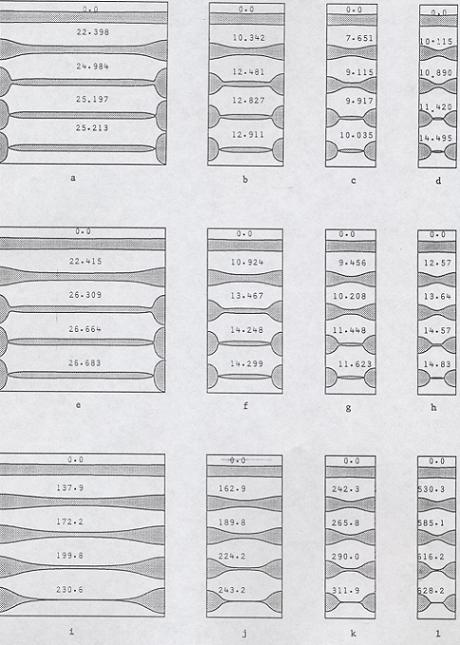
We have conducted both temporal and spacial instability of a liquid jet numerically. The Galerkin finite element method is used along with the height-flux method for the advection and reconstruction of the free surface of the jet. We have found that the satellite drops are persistently formed after the breakup. Only for very small Reynolds number (Re) the satellite drops are not observed. Both the initial disturbance wavenumber and amplitude determine the Re below which no satellite is formed. We have provided the limiting Re for any given disturbance wavenumber and for small initial disturbance amplitudes, below which no satellites are observed. An increase in the initial disturbance amplitude will shift the no-satellite region to higher Re numbers.
Since for fundamental disturbance wavenumbers larger than 0.5 the higher harmonics are stable, the behavior of the jet subject to stable wavenumbers is also investigated. The results show that the jet in the stable region may have underdamped or overdamped oscillations. The controlling parameters are Re, k and initial amplitudes.
We have conducted the following jet instability studies:
Temporal Analysis of Capillary Jet Breakup
Non-linear Instability of Liquid Jets with Thermocapillarity
Nonlinear Instability of an Evaporating Capillary Jet
Instability of a Liquid Jets Subject to Disturbances Composed of Two Wavenumbers
Spatial instability of liquid jet with high disturbance amplitudes
Instability of a liquid jet with a source of mass
IMPINGING JETS
Jet-on-jet impinging atomizers are typically used in liquid propellant rocket engines where fast mixing between liquid fuel and liquid oxidizer is essential. Liquid jets of fuel and oxidizer collide and breaks up into a spray that vaporizes and combusts. Some interesting visualization studies of impinging jets for various jet velocities and impingement angles were performed. When two jets collide they form a sheet in the direction perpendicular to the jets. Waves form on the surface of the sheet and grow until the sheet breakups into small droplets.
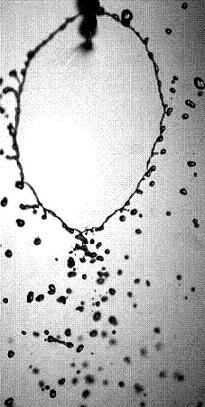
We have conducted experimental investigation of a spray formed by the impingement of two water jets. A Patternator as well as a Phase Doppler Particle Analyzer are used for the spray characterization. For each test condition the extend of mixing between the two streams is measured. A mixing correlations for mixing in such impingers as a function of jet velocity and impingement angle is developed.
LIQUID BRIDGES
An experimental investigation of forced and free oscillations of liquid bridges positioned between two rods of equal diameter is presented. Both the resonance frequencies and damping rates for different aspect ratios of the bridge are reported. The damping rate data of the liquid bridges are obtained by high-speed videography and are the first-ever to be reported. Resonance frequencies for the three modified Reynolds numbers of 14, 295 and 1654, and damping rates for the two modified Reynolds numbers of 14 and 295 are reported. Using ethylene glycol, distilled water, and mercury in small bridges generates these values of modified Reynolds numbers. Gravitational effects are kept to a minimum by reducing the size of the capillary bridge. The internal flow fields of several bridges for different modified Reynolds numbers are described based on high-speed visualization. Experimental results show good agreement with the results of linear and nonlinear theory.
